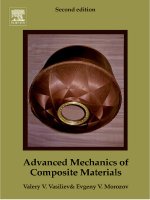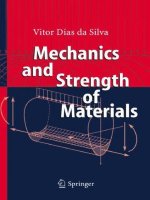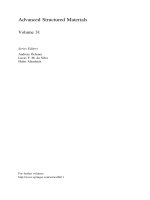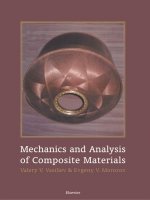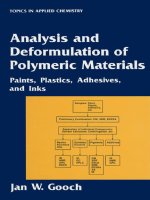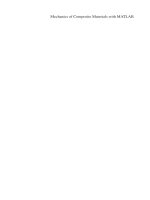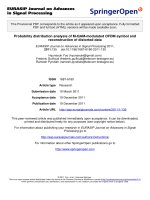Mechanics and Analysis of Composite Materials ppt
Bạn đang xem bản rút gọn của tài liệu. Xem và tải ngay bản đầy đủ của tài liệu tại đây (11.96 MB, 430 trang )
Mechanics and Analysis
of
Composite Materials
Valery
V,
Vasiliev
&
Evgeny
I?
Morozov
Elsevier
MECHANICS
AND ANALYSIS
OF
COMPOSITE
MATERIALS
MECHANICS
AND
ANALYSIS
OF
COMPOSITE
MATERIALS
Valery
V.
Vasiliev
Professor
of
Aerospace Composite Structures
Director
of
School of Mechanics and Design
Russian State University
of
Technology, Moscow
Evgeny
V.
Morozov
Professor of Manufacturing Systems
School
of Mechanical Engineering
University
of
Natal, South Africa
200
1
ELSEVIER
AMSTERDAM. LONDON
.
NEW
YORK
.
OXFORD. PARIS. SHANNON TOKYO
ELSEVIER SCIENCE Ltd
The Boulevard, Langford Lane
Kidlington,
Oxford
OX5
lGB,
UK
@
2001
Elsevier Science Ltd.
All
rights reserved.
This
work
is
protected under copyright by Elsevier Science, and the following terms and conditions apply to
its
use:
Photocopying:
Single photocopies of single chapters may
be
made for personal usc
i15
allowed by national copyright laws. Permission
of
the Publisher and
payment of a fee is required for
all
other photocopying, including multiple or systemiltic copying. copying for adverlising or promotional
purposes, resale. and
all
forms of document delivery. Special rates arc available for educational institutions that wish
to
make photocopies for
non-prnfit educational classroom
use.
Permissions may
be
sought directly from Elsevier Science Global Rights Department,
Po
Box
800,
Oxford
OX5
IDX.
UK
phonc:
(4)
1865
843830. fax:
(4)
1865
853333, e-mail:
permissionsgelsevier.co.uk.
You
may
also
contact Global Rights directly through Elsevier's home
page
(),
by sclccting 'Obtaining Permissions'.
In the USA,
users
may clear permissions and make payments through the Copyright Clearance Center. Inc
222
Rosewmd Drive, Dan\*ers.
MAOIYU,
USA;
phonc: (+1)(978) 7508400. fax: (+1)(978)7504744,and in the
UK
through thecopyright Licensing Agency Rapidclearance
Service (CLARCS).
90
Tottenham Court Road. London W
I
P 0LP.
UK:
phone:
(44)
207 63
I
5555:
fax: (44) 207 63
I
5500. Other countries
may have a local reprographic rights agency for payments.
Derivative Works:
Tables of contents may
be
reproduced for internal circulution. but permission of Elsevier Science is requircd for external resale or distribution
of such material. Permission of
thc
Publisher is required for
all
other dcrivative works. including compilations and translations.
Electronic Storage or Usage:
Permission of the Publisher
is
required to storc or use electronically any material contained in this work, including any chapter
or
pan
of
a
chapter.
Except
as
outlined above, no
part
of this work may be rcproduced, stored in
a
retrieval systcni or transmitted in any form
or
by any means.
electronic, mechanical, photocopying, recording or otherwise. without prior written permission of the Publisher.
Addrcss permissions requests to: Elsevier Science Global Rights Department. at the mail. fax and e-mail addresses noted above.
Noticc:
No
responsibility is assumed by the Publisher for any injury and/or damage
to
persons or property as
a
matter of products liability. negligence
or otherwise, or from any use
or
operation of any methods, products. instructions or ideas contained in the material hercin. Because of npid
advances in the medical sciences. in particular, independent verification
of
diagnoses and drug dosages should be made.
First edition
2001
ISBN:
0-08-042702-2
British Library Cataloguing in Publication Data
Vasiliev, Valery V.
Mechanics and analysis of composite materials
1
Composite materials
-
Mechanical properlieq
I.Tit1e II.Morozov, Evgeny V.
620.1
'
1892
ISBN 0OX0427022
Library
of
Congress Cataloging-in-Publication
Data
Vasiliev, Valery
V.
Mechanics and analysis
of
composite materials
/
Valery
V. Vasiliev, Evgeny V.
Morozov.
1st
ed.
p. cm.
Includes bibliographical references and index.
ISBN
0-08-042702-2 (hardcover)
I
.Composite materials Mechanical Properties.
2.
Fibrous comp~~sites Mechanical
properties.
1.
Mornzov. Evgeny V.
11.
Title.
TA418.9.C6V375 2(WW
62O.l'1892 dc21
(W)-06
176.5
GI
The paper
used
in this publication meets the requirements
of
ANSVNISO
239.48-1992
(Permanence
of
Paper).
Printed in The Netherlands
PREFACE
This book is concerned with the topical problems of mechanics of advanced
composite materials whose mechanical properties are controlled by high-strength
and high-stiffness continuous fibers embedded in polymeric, metal, or ceramic
matrix. Although the idea
of
combining two or more components to produce
materials with controlled properties has been known and used from time
immemorial, modern composites have been developed only several decades ago
and have found by now intensive application in different fields of engineering,
particularly, in aerospace structures for which high strength-to-weightand stiffness-
to-weight ratios are required.
Due to wide existing and potential applications, composite technology has been
developed very intensively over recent decades, and there exist numerous publica-
tions that cover anisotropic elasticity, mechanics
of
composite materials, design,
analysis, fabrication, and application
of
composite structures. According to the list
of
books on composites presented in Mechanics
of
Fibrous Composites by C.T.
Herakovich (1998) there were
35
books published in this field before 1995, and this
list should be supplemented now with at least five new books.
In connection with this, the authors were challenged with
a
natural question as to
what causes the necessity to publish another book and what is the differencebetween
this book and the existing ones. Concerning this question, we had at least three
motivations supporting
us
in this work.
First, this book
is
of a more specificnature than the published ones which usually
cover not only mechanics of materials but also include analysis
of
composite beams,
plates and shells, joints, and elements of design
of
composite structures that, being
also important, do not strictly belong to mechanics of composite materials. This
situation looked quite natural because composite science and technology, having
been under intensive development only over several past decades, required the books
of a universal type. Nowadays however, application
of
composite materials has
reached the level at which special books can be dedicated to all the aforementioned
problems of composite technology and, first of all, to mechanics
of
composite
materials which is discussed in this book in conjunction with analysis of composite
materials.
As
we hope, thus constructed combination of materials science and
mechanics of solids has allowed us to cover such specific features of material
behavior as nonlinear elasticity, plasticity, creep, structural nonlinearity and discuss
in
detail the problems of material micro-and macro-mechanics that are only slightly
touched
in
the existing books, e.g., stress diffusion in a unidirectional material with
broken fibers, physical and statistical aspects
of
fiber strength, coupling effects
in
anisotropic and laminated materials, etc.
Second, this book, being devoted
to
materials,
is
written by designers
of
composite structures who over the last
30
years were involved in practically all main
V
vi
Preface
Soviet and then Russian projects in composite technology. This governs the list of
problems covered in the book which can be referred to as material problems
challenging designers and determines the third of its specific features
-
discussion is
illustrated with composite parts and structures built within the frameworks of these
projects. In connection with this, the authors appreciate the permission of the
Russian Composite Center
-
Central Institute of Special Machinery (CRISM) to use
in the book the pictures of structures developed and fabricated in CRISM as part of
the joint research and design projects,
The book consists of eight chapters progressively covering all structural levels of
composite materials from their components through elementary plies and layers to
laminates.
Chapter
1
is an Introduction in which typical reinforcing and matrix materials as
well as typical manufacturing processes used in composite technology are described.
Chapter
2
is also a sort
of
Introduction but dealing with fundamentals of
mechanics of solids, i.e., stress, strain, and constitutive theories, governing
equations, and principles that are used in the next chapters for analysis of
composite materials.
Chapter
3
is devoted to the basic structural element of a composite material
-
unidirectional composite ply.
In
addition to traditional description of microme-
chanical models and experimental results, the physical nature
of
fiber strength, its
statistical characteristics and interaction of damaged fibers through the matrix are
discussed, and an attempt is made to show that fibrous composites comprise a
special class
of
man-made materials utilizing natural potentials of material strength
and structure.
Chapter
4
contains a description
of
typical composite layers made
of
unidirec-
tional, fabric, and spatially reinforced composite materials. Traditional linear elastic
models are supplemented in this chapter with nonlinear elastic and elastic-plastic
analysis demonstrating specific types
of
behavior of composites with metal and
thermoplastic matrices.
Chapter
5
is concerned with mechanics of laminates and includes traditional
description of the laminate stiffness matrix, coupling effects in typical laminates and
procedures of stress calculation for in-plane and interlaminar stresses.
Chapter
6
presents a practical approach to evaluation
of
laminate strength. Three
main types
of
failure criteria, i.e., structural criteria indicating the modes of failure,
approximation polynomial criteria treated as formal approximations of experimen-
tal data, and tensor-polynomial criteria are analyzed and compared with available
experimental results for unidirectional and fabric composites.
Chapter
7
dealing with environmental, and special loading effects includes
analysis of thermal conductivity, hydrothermal elasticity, material aging, creep, and
durability under long-term loading, fatigue, damping and impact resistance of
typical advanced composites. The influence of manufacturing factors on material
properties and behavior is demonstrated for filament winding accompanied with
nonuniform stress distribution between the fibers and ply waviness and laying-up
processing of nonsymmetric laminate exhibiting warping after curing and cooling.
Preface
vii
The last Chapter
8
covers a specific for composite materials problem of material
optimal design and presents composite laminates
of
uniform strength providing high
weight efficiency
of
composite structures demonstrated for filament wound pressure
vessels.
The book is designed to
be
used by researchers and specialists
in
mechanical
engineering involved
in
composite technology, design, and analysis of composite
structures. It can be also useful
for
graduate students in engineering.
Vulery V. Vasiliev
Evgeny V. Morozov
CONTENTS
Preface
v
Chapter
1.
Introduction
1
1.1.
Structural Materials
1
1.2.
Composite Materials 9
1.2.1.
Fibers for Advanced Composites
10
1.2.2. Matrix Materials 16
1.2.3. Processing 21
1.3. References 27
Chapter
2.
Fundamentals of Mechanics
of
Solids
29
2.1.
2.2.
2.3.
2.4.
2.5.
2.6.
2.7.
2.8.
2.9.
2.10.
2.11.
2.11.1.
2.1 1.2.
2.11.3.
2.12.
Stresses 29
Equilibrium Equations 30
Stress Transformation 32
Principal Stresses 34
Displacements and Strains 36
Transformation of Small Strains
39
Compatibility Equations 40
Admissible Static and Kinematic Fields 41
Constitutive Equations for an Elastic Solid 41
Formulations of the Problem 48
Variational Principles 49
Principle
of
Minimum Total Potential Energy
50
Principle of Minimum Strain Energy 52
Mixed Variational Principles 52
References 53
Chapter
3.
Mechanics
of
a Unidirectional
Ply
55
3.1.
Ply Architecture
55
3.2. Fiber-Matrix Interaction 58
3.2.1. Theoretical and Actual Strength
58
3.2.2. Statistical Aspects of Fiber Strength 62
3.2.3. Stress Diffusion in Fibers Interacting Through the Matrix 65
3.2.4. Fracture Toughness 79
3.3. Micromechanics of a Ply
80
3.4. Mechanical Properties of a Ply under Tension, Shear, and
Compression
95
ix
X
Cunrenrs
3.4.1.
3.4.2.
3.4.3.
3.4.4.
3.4.5.
3.5.
3.6.
3.7.
Longitudinal Tension 95
Transverse Tension 97
In-Plane Shear
100
Longitudinal Compression 103
Transverse Compression
1
13
Hybrid Composites
1
13
Phenomenological Homogeneous Model of a Ply
References
1
19
117
Chapter
4.
Mechanics
of
a Composite Layer
121
4.1.
4.1.1.
4.1.2.
4.2.1.
4.2.2.
4.3.1.
4.3.2.
4.4.1.
4.4.2.
4.5.1.
4.5.2.
4.5.3.
4.2.
4.3.
4.4.
4.5.
4.6.
4.7.
4.8.
4.9.
Isotropic Layer 121
Linear Elastic Model 121
Nonlinear Models I24
Unidirectional Orthotropic Layer 140
Linear Elastic Model 140
Nonlinear Models 142
Unidirectional Anisotropic Layer 147
Linear Elastic Model 147
Nonlinear Models 161
Orthogonally Reinforced Orthotropic Layer 163
Linear Elastic Model 163
Nonlinear Models 166
Angle-Ply Orthotropic Layer 184
Linear Elastic Model 185
Nonlinear Models 188
Free-Edge Effects 201
Fabric Layers 205
Lattice Layer 2 I2
Spatially Reinforced Layers and Bulk Materials 214
References 222
Chapter
5.
Mechanics
of
Laminates
225
5.1.
5.2.
5.3.
5.4.
5.4.1.
5.4.2.
5.4.3.
5.5.
5.6.
5.7.
5.8.
Stiffness Coefficients
of
a Generalized Anisotropic Layer 225
Stiffness Coefficients
of
a Homogeneous Layer 236
Stiffness Coefficients
of
a Laminate 238
Quasi-Homogeneous Laminates 240
Laminate Composed
of
Identical Homogeneous Layers 240
Laminate Composed
of
Inhomogeneous Orthotropic Layers 240
Laminate Composed
of
Angle-Ply Layers 242
Quasi-Isotropic Laminates 243
Symmetric Laminates 245
Antisymmetric Laminates 248
Sandwich Structures 249
Contents
xi
5.9. Coordinate of the Reference Plane 251
5.10. Stresses in Laminates 254
5.11. Example 256
5.12. References 269
Chapter
6.
Failure Criteria and Strength
of
Laminates
271
6.1. Failure Criteria for an Elementary Composite Layer
or
Ply 271
6.1.1. Maximum Stress and Strain Criteria 274
6.1.2. Approximation Strength Criteria 281
6.1.3. Interlaminar Strength 284
6.2. Practical Recommendations and Discussion 285
6.3. Examples 294
6.4. References 300
Chapter
7.
Environmental, Special Loading, and Manufacturing Effects
301
7.1. Temperature Effects 301
7.
I.
1.
Thermal Conductivity 302
7.1.2. Thermoelasticity 307
7.2. Hydrothermal Effects and Aging 317
7.3. Time and Time-Dependent Loading Effects 319
7.3.1. Viscoelasticity 319
7.3.2. Durability 332
7.3.3. Cyclic Loading 334
7.3.4. Impact Loading 340
7.4. Manufacturing Effects 350
7.5. References 362
Chapter
8.
Optimal Composite Structures 365
8.1. Optimal Fibrous Structures 365
8.2. Composite Laminates
of
Uniform Strength 372
8.3. Application to Pressure Vessels 379
8.4. References 392
Author Index
393
Subject Index
397
Chapter
1
INTRODUCTION
1.1.
Structural
materials
Material is the basic element of all natural and man-made structures. Figuratively
speaking it materializes the structural conception. Technological progress is
associated with continuous improvement of existing material properties as well as
with expansion of structural material classes and types. Usually, new materials
emerge due to necessity to improve the structure efficiency and performance, but as
a rule, new materials themselves in turn provide new opportunities to develop
updated structures and technology, while the latter presents material science with
new problems and tasks. One
of
the best manifestations of this interrelated
process in development of materials, structures, and technology is associated with
composite materials to which this book is devoted.
Structural materials should possess a great number of physical, chemical and
other types of properties, but there exist at least two principal characteristics that
are of primary importance. These characteristics are stiffness and strength that
provide the structure with the ability to maintain its shape and dimensions under
loading or any other external action.
High stiffness means that material exhibits low deformation under loading.
However, saying that stiffness is an important property we do not mean that it
should be necessarily high. Ability of structure to have controlled deformation
(compliance) can be also important for some applications (e.g., springs; shock
absorbers; pressure, force, and displacement gauges).
Shortage of material strength results in uncontrolled compliance, i.e., in failure
after which a structure does not exist any more. Usually, we need to have as
high strength as possible, but there are some exceptions (e.g., controlled failure
of
explosive bolts is used to separate rocket stages).
Thus,
without controlled stiffness and strength the structure cannot exist.
Naturally, both properties depend greatly on the structure design but are
determined by stiffness and strength of the structural material because a good
design is only a proper utilization
of
material properties.
To
evaluate material stiffness and strength, consider the simplest test
-
a bar with
cross-sectional area
A
loaded with tensile force
F
as shown in Fig. 1.1. Obviously,
1
2
Mechanics and analysis
of
composite materials
Fig.
1.1.
A
bar
under tension.
the higher is the force causing the bar rupture the higher is the bar strength.
However, this strength depends not only on the material properties
-
it is
proportional to the cross-sectional area
A.
Thus, it is natural to characterize
material strength with the ultimate stress
F
A’
a=-
where
F
is the force causing the bar failure (here and further we use the overbar
notation to indicate the ultimate characteristics).
As
follows from Eq. (1. l), stress
is measured in force divided by area, i.e., according to international
(SI)
units,
in pascals (Pa)
so
that
1
Pa
=
1
N/m2. Because loading of real structures induces
relatively high stresses, we also use kilopascals
(1
kPa
=
IO3
Pa), megapascals
(1
MPa=
lo6
Pa), and gigapascals (1 GPa
=
10’
Pa). Conversion
of
old metric
(kilogram per square centimeter) and English (pound per square inch) units
to pascals can be done using the following relations:
1
kg/cm2=98 kPa and
1
psi
=
6.89
kPa.
For some special (e.g., aerospace or marine) applications, Le., for which material
density,
p,
is
also
important, a normalized characteristic
a
k,
=
-
P
is also used to describe the material. This characteristic is called “specific strength”
of
the material. If we use old metric units, Le., measure force and mass in kilograms
and dimensions in meters, substitution of
Eq.
(1.1)
into Eq.
(1.2)
yields
k,
in meters.
This result has
a
simple physical sense, namely
k,
is the length of the vertically
hanging fiber under which the fiber will be broken by its own weight.
Stiffness
of
the bar shown in Fig.
1.1
can be characterized with an elongation
A
corresponding to the applied force
F
or acting stress
u
=
F/A.
However,
A
is
proportional to the bar length
LO.
To
evaluate material stiffness, we introduce strain
A
LO
E=
Since
E
is very small for structural materials the ratio in
Eq.
(1.3)
is normally
multiplied by
100,
and
E
is expressed as a percentage.
Chapter
1.
Introduction
3
Naturally, for any material, there should exist some interrelation between stress
and strain, i.e.
E
=f’(o)
or
c
=
(~(8).
(
1.4)
These equations specify the so-called constitutive law and are referred to as
constitutive equations. They allow us to introduce an important concept of the
material model which represents some idealized object possessing only those
features of the real material that are essential for the problem under study. The
point is that performing design or analysis we always operate with models rather
than with real materials. Particularly, for strength and stiffness analysis, this model
is
described by constitutive equations, Eqs. (1.4), and is specified by the form of
function
/(a)
or
(P(E).
The simplest is the elastic model which implies that
AO)
=
0,
cp(0)
=
0
and that
Eqs. (1.4) are the same for the processes of an active loading and an unloading. The
corresponding stress-strain diagram
(or
curve) is presented in Fig
1.2.
Elastic
model (or elastic material) is characterized with two important features. First, the
corresponding constitutive equations, Eqs. (1.4), do not include time as a parameter.
This means that the form of the curve shown in Fig.
1.2
does not depend on the rate
of loading (naturally,
it
should be low enough to neglect the inertia and dynamic
effects). Second, the work performed by force
F
is accumulated
in
the bar as
potential energy, which is also referred to as strain energy or elastic energy.
Consider some infinitesimal elongation dA and calculate elementary work
performed by the force
F
in
Fig
1.1 as
d
W=
F
dA. Then, work corresponding to
point 1 of the curve in Fig. 1.2 is
where
A,
is
the elongation
of
the bar corresponding to point
1
of
the curve. The
work
W
is equal to elastic energy of the bar which
is
proportional to the bar volume
and can be presented as
4
Mechanics and analysis
of
composite materials
where
o
=
F/A,
E
=
A/L0,
and
el
=
Al/Lo.
Integral
is a specific elastic energy (energy accumulated in the unit volume of the bar) that
is
referred to as an elastic potential. It is important that
U
does not depend on the
history
of
loading. This means that irrespective of the way we reach point 1 of the
curve in Fig 1.2 (e.g., by means of continuous loading, increasing force
F
step by
step, or using any other loading program), the final value
of
U
will
be
the same and
will depend only on the value
of
final strain
el
for the given material.
A
very important particular case
of
the elastic model is the linear elastic model
described by the well-known Hooke’s law (see Fig. 1.3)
Here,
E
is the modulus of elasticity.
As
follows from
Eqs.
(1.3)
and
(1.6),
E
=
o
if
E
=
1,
Le. if
A
=
LO.
Thus, modulus can be interpreted as the stress causing
elongation
of
the bar in Fig.
1.1
as high as the initial length. Because the majority
of
structural materials fails before such a high elongation can occur, modulus
is
usually
much higher then the ultimate stress
8.
Similar to specific strength
k,
in
Eq.
(1.2), we can introduce the corresponding
specific modulus
E
kE
-
P
determining material stiffness with respect to material density.
Fig.
1.3.
Stress-strain diagram
for
a linear elastic material.
Chapter
1.
Introduction
5
Absolute and specific values of mechanical characteristics for typical materials
discussed in this book are listed in Table
1.1.
After some generalization, modulus can be used to describe nonlinear material
behavior of the type shown in Fig.
1.4.
For this purpose, the so-called secant,
E,,
and tangent,
Et,
moduli are introduced as
While the slope
01
in Fig.
I
.4
determines modulus
E,
the slopes
p
and
y
determine
Es
and
E,,
respectively.
As
it can be seen,
Es
and
E,,
in contrast to
E,
depend on the level
of loading, i.e., on
IJ
or
E.
For a linear elastic material (see Fig.
1.3),
E,
=
Et
=
E.
Hooke’s law,
Eq.
(1.6),
describes rather well the initial part of stress-strain
diagram
for
the majority of structural materials. However, under relatively high
level
of
stress or strain, materials exhibit nonlinear behavior.
One
of
the existing models is the nonlinear elastic material model introduced
above (see Fig.
1.2).
This model allows us to describe the behavior of highly
deformable rubber-type materials.
Another model developed to describe metals is the so-called elastic-plastic
material model. The corresponding stress-strain diagram is shown in Fig.
1.5.
In
contrast to elastic material (see Fig.
1.2),
the processes
of
active loading and
unloading are described with different laws in this case. In addition to elastic strain,
E~,
which disappears after the load is taken
off,
the residual strain (for the bar shown
in Fig.
1.1,
it is plastic strain,
sp)
retains in the material. As for an elastic material,
stress-strain curve in Fig. 1.5 does not depend on the rate
of
loading
(or
time of
loading). However, in contrast to an elastic material, the final strain of an elastic-
plastic material can depend on the history of loading, Le., on the law according to
which the final value of stress was reached.
Thus, for elastic or elastic-plastic materials, constitutive equations, Eqs.
(1.4),
do
not include time. However, under relatively high temperature practically all the
materials demonstrate time-dependent behavior (some of them do it even under
room temperature). If we apply to the bar shown in Fig.
1.1
some force
F
and keep
it constant, we can see that for a time-sensitive material the strain increases under
constant force. This phenomenon is called the creep
of
the material.
So,
the most general material model that
is
used in this book can be described
with the constitutive equation of the following type:
E
=f(o,
t,
0
,
(1-9)
where
t
indicates the time moment, while
CJ
and
T
are stress and temperature
corresponding
to
this moment. In the general case, constitutive equation,
Eq.
(1.9),
specifies strain that can be decomposed into three constituents corresponding to
elastic, plastic and creep deformation, i.e.
E=&,+Ep+ec
.
(1.10)
6
Mechanics and analysis
of
composite
materials
Table
1.1
Mechanical properties of structural materials and fibers.
Material Ultimate Modulus, Specific Maximum Maximum
tensile stress,
E
((;Pa) gravity specific specific
if
(MPa) strength, modulus,
ko
x
10’
(m)
kE
x
10%
(m)
Metal alloys
Steel
Aluminum
Titanium
Magnesium
Beryllium
Nickel
Metal wires (diameter, pm)
Steel
(20-1500)
Aluminum
(
150)
Titanium
(I
00-800)
Beryllium
(50-500)
Tungsten
(20-50)
Molybdenum
(25-250)
Thermoset polymeric resins
EPOXY
Polyester
Phenol-formaldeh yde
Organosilicone
Polyimide
Bismaleimide
Thermoplastic polymers
Polyethylene
Polystyrene
Teflon
Nylon
Polyester (PC)
Polysulfone (PSU)
Polyamide-imide (PAI)
Polyetheretherketone (PEEK)
Polyphenylenesulfide (PPS)
Capron
Dacron
Teflon
Nitron
Polypropylene
Viscose
Synthetic fibers
770-2200
260-700
1000-1200
260
620
400-500
150M400
290
1400-
1
500
1100-1450
3300-4000
1800-2200
6&90
30-70
40-70
25-50
55-1
10
80
20-45
3545
15-35
80
60
70
90-190
9&100
80
680-780
390-880
3MO
390-880
730-930
930
Fibers
for
advanced composites (diameter,
pm)
Glass
(3-19)
3
100-5000
Quartz
(10) 6000
Basalt
(9-13) 3000-3500
18&210
69-72
110
40
320
200
180-200
69
I20
240-310
410
360
2.4-4.2
2.8-3.8
7-1
1
6.&10
3.2
4.2
6-8.5
30
3.5
2.8
2.5
2.7
2.84.4
3.1-3.8
3.5
4.4
4.915.7
2.9
4.9-8.8
4.4
20
72-95
74
90
7.8-7.85 28.8
2.7-2.85 26.5
4.5 26.7
1.8
14.4
1.85 33.5
8.9 5.6
7.8 56.4
2.7 10.7
4.5
33.3
1.8-1.85 80.5
19-19.3 21.1
10.2 21.5
1.2-1.3 7.5
1.2-1.35 5.8
1.2-1.3 5.8
1.35-1.4 3.7
1.3-1.43 8.5
1.2 6.7
0.95
4.7
1.05 4.3
2.3 1.5
1.14 7.0
1.32 4.5
1.24 5.6
I
.42 13.4
1.3
7.7
1.36 5.9
1.1
70
1.4
60
2.3
190
1.2 70
0.9
IO0
1.52 60
2.4-2.6 200
2.2 270
2.7-3.0
130
2750
2670
2440
2220
17300
2250
2560
2550
2670
17200
2160
3500
350
3
IO
910
740
240
3
50
890
2860
150
240
190
220
360
300
250
400
1430
130
730
480
1300
3960
3360
3300
Aramid
(12-15) 3500-5500 140-180 1.4-1.47 390
12800
Chapter
1.
Introduclion
7
Table
1.1
(Contd.)
Material Ultimate Modulus
E
Specific Maximum Maximum
tensile stress, (GPa) gravity specific specific
C
(MPa)
strength, modulus,
k,
x
lo3
(m)
kF:
x
IO3
(m)
Polyethylene (20-40) 2600-3300 120-170 0.97
310
17500
Carbon (5-1
1)
High-strength 7000 300 1.75
400
17100
High-modulus 2700
850
1.78 150 47700
Boron
(
1
O(r200)
2500-3700 39M20 2.5-2.6
150
16800
Alumina
-
A1203
(20-500)
240W100
470-530 3.96
100
13300
Silicon Carbide
-
Sic (1
&I
5)
2700
185
2.4-2.7
110
7700
Titanium Carbide
-
Tic (280) 1500 450 4.9 30 9100
Boron
Nitride
-
BN (7)
1400
90
1.9 70
4700
Boron Carbide
-
B&
(50)
2
100-2500 480
2.5
100 10000
Fig.
1.4.
Introduction
of
secant and tangent moduli.
Fig. 1.5. Stress-strain diagram
for
elastic-plastic material.
However, in application
to
particular problems, this model
can
be usually
substantially simplified.
To
show this, consider the bar in
Fig.
1.1
and assume
that force
F
is applied at the moment
t=O
and is taken
off
at moment
t
=
tl
as
shown
in
Fig.
1.6(a).
At the moment
t
=
0,
elastic and plastic strains that
do
not
depend on time appear, and while time
is
running, the creep strain is developed. At
8
Mechanics
and
analysis
of
composite
malerials
IF
t
t
Fig.
1.6.
Dependence of force
(a)
and strain
(b)
on time.
the moment
t
=
tl
elastic strain disappears, while reversible part of the creep strain,
E:,
disappears in time. Residual strain consists of the plastic strain,
ep,
and residual
part of the creep strain,
E:.
Now assume that
cp
-=K
which means that either material is elastic
or
the applied
load does not induce high stress
and,
hence, plastic strain. Then we can neglect
cp
in
Eq.
(I
.IO)
and simplify the model. Furthermore let
EC
<<
EC
which in turn means that
either material is not susceptible to creep or the force acts for
a
short time
(ti
is close
to zero). Thus we arrive at the simplest elastic model which is the case for the
majority of practical applications.
It
is important that the proper choice
of
the
material model depends not only on the material nature and properties but also on
the operational conditions of the structure. For example, a shell-type structure made
of aramid-epoxy composite material, that is susceptible to creep, and designed to
withstand the internal gas pressure should be analyzed with due regard to the creep
if this structure is a pressure vessel for long term gas storage. At the same time for a
solid propellant rocket motor case working for seconds, the creep strain can be
ignored.
A very important feature of material models under consideration is their
phenomenological nature. This means that these models ignore the actual material
microstructure (e.g., crystalline structure of metals
or
molecular structure of
polymers) and represent the material as some uniform continuum possessing some
effective properties that are the same irrespective of how small the material volume
is. This allows us, first, to determine material properties testing material samples
(as in Fig.
1.1).
Second, this formally enables
us
to apply methods of Mechanics of
Chapter
1.
Introduction
9
Solids that deal with equations derived for infinitesimal volumes of material. And
third, this allows
us
to simplify the strength and stiffness evaluation problem and
to reduce it to a reasonable practical level not going into analysis of the actual
mechanisms of material deformation and fracture.
1.2.
Composite materials
This book is devoted to composite materials that emerged in the middle of the
20th century as
a
promising class of engineering materials providing new prospects
for modern technology. Generally speaking any material consisting of two or more
components with different properties and distinct boundaries between the compo-
nents can be referred to as a composite material. Moreover, the idea of combining
several components to produce a material with properties that are not attainable
with the individual components has been used by man for thousands of years.
Correspondingly, the majority of natural materials that have emerged as a result of
a prolonged evolution process can be treated as composite materials.
With respect to the problems covered in this book we can classify existing
composite materials (composites) into two main groups.
The first group comprises composites that are known as “filled materials”. The
main feature of these materials is the existence of some basic or matrix material
whose properties are improved by filling it with some particles. Usually the matrix
volume fraction is more than
50%
in such materials, and material properties, being
naturally modified by the fillers, are governed mainly
by
the matrix. As
a
rule, filled
materials can be treated as homogeneous and isotropic, i.e., traditional models
of
Mechanics of Materials developed for metals and other conventional materials can
be used to describe their behavior. This group of compositesis not touched on in the
book.
The second group
of
composite materials that is under study here involves
composites that are called “reinforced materials”. The basic components of these
materials (sometimes referred to as “advanced composites”) are long and thin fibers
possessing high strength and stiffness. The fibers are bound with a matrix material
whose volume fraction in
a
composite is usually less than 50%. The main properties
of
advanced composites due to which these materials find a wide application in
engineering are governed by fibers whose types and characteristics are considered
below.
The following sections provide a concise description of typical matrix materials
and fiber-matrix compositions. Two comments should be made with respect to the
data presented in those sections. First, only a brief information concerning material
properties that are essential for the problems covered in this book is presented there,
and, second, the given data are of a broad nature and are not expected
to
be used in
design or analysis of particular composite structures. More complete description
of
composite materials and their components including the history of development and
advancement, chemical compositions, physical characteristics, manufacturing, and
applications can be found elsewhere (Peters,
1998).
10
Mechanics and analysis
of
composite materials
1.2.1.
Fibers
for
advanced composites
Continuous glass fibers (the first type of fibers used in advanced composites) are
made by pulling molten glass (at a temperature about
1300°C)
through
0.8-3.0
mm
diameter dies and further high-speed stretching to a diameter
of
3-19
pm. Usually
glass fibers have solid circular cross sections. However there exist fibers with
rectangular (square or plane), triangular, and hexagonal cross sections,
as
well as
hollow circular fibers. Typical mechanical characteristics and density of glass fibers
are listed in Table
1.1,
while typical stress-strain diagram is shown in Fig.
1.7.
Important properties of glass fibers as components of advanced composites for
engineering applications are their high strength which is maintained in humid
environments but degrades under elevated temperatures (see Fig.
1.8),
relatively
low stiffness (about
40%
of the stiffness
of
steel), high chemical and biological
resistance, and
low
cost. Being actually elements
of
monolithic glass, the fibers do
not absorb water and change their dimensions in water. For the same reason, they
are brittle and sensitive
to
surface damage.
Quartz fibers are similar to glass fibers and are obtained by high-speed stretching
of quartz rods made of (under temperature of about
2200°C) fused quartz crystals
or sand. Original process developed for manufacturing of glass fibers cannot be used
7-
6-
5-
4
4-
0
D
3-
E
.%
Fig. 1.7.
Stress-strain
diagrams
for
typical
fibers
of
advanced composites.

